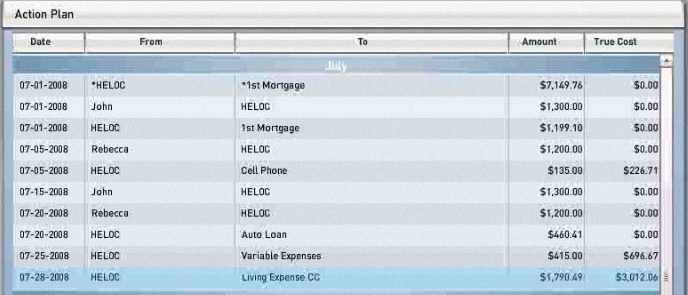Today, I’d like to share with you the MMA dashboard, a snapshot taken from an official demo video.

Note: You may click on it to see a larger image.
First, I’d note that it’s pretty convenient that the living expenses credit card has a due date right at month’s end. The main card I use happens to cut a bill toward the end of the month with a mid-month due date. That’s okay, it’s their example, I understand they wish to put the system in the best light possible. Let’s look more closely at the first month, July. There are a total of 10 transactions, 4 pay checks coming in, and six payments made from the HELOC. Seems pretty simple to me that for all the “sophisticated algorithms”, MMA can be summed up in two rules; (1) Pay all your bills with the HELOC and (2) deposit your paychecks directly to the HELOC. Is this the best they can come up with? What we don’t know, however, is the internal workings of MMA, specifically how it calculated that first mortgage paydown of $7149.76. A very precise number, why not $7000 even or one month’s income of the sample clients ($5000)? Funny, when you add up the HELOC withdrawals and payments, the July ending balance is $6149.76, and average daily balance which is used to calculate interest, $5542. Here’s where it gets interesting. In the classic example, the mortgage rate is 6% and the HELOC rate is 9%. The interest saved in one month by making that prepayment on July 1 is $7149.76 * .06 = $428.99 per year or $35.75 in the first month. But – the interest on the HELOC is $5542 * .09= $498.85 /yr or $41.57 that same month. In this example, it’s clear that MMA cannot even calculate the best first prepayment/HELOC withdrawal. As I’ve stated in other posts, I agree it’s possible for the HELOC shuffle to provide some benefit, but not enough even to pay off the cost of the MMA program. If this is MMA watching every last penny at every moment, I’ll be sure to watch my dollars myself, and I’d suggest you do the same. (Any agents care to comment on this?)
Joe
Back next week for more MMA discussion.

Joe, this is a very good question. How do they come up with that number? As someone who has made available a piece of software that calculates the same information, I can say that I really don’t understand what their criteria is and can’t make any sense of it. For $3500, they should come clean about how the magic computations work.
Hey Joe,
The amount of money MMA pulls out should be related to the following items:
1) The amount of monthly discretionary income – Since it seems MMA tries to pull out big chunks every 3 months, MMA needs to know that it can pay it down in that time.
2) Minimum monthly HELOC balance – Because MMA uses HELOC balance reduction, the HELOC balance can never be allowed to get to zero during the month.
3) Oops factor – If a client were to get some extra cash, MMA wants to be able to apply that to the HELOC balance without running the risk that the HELOC balance reaches zero and the client will have to move that extra cash into a checking account. While an extra bi-weekly paycheck can be calculated and accounted for, any other found cash can’t and would ruin the illusion of MMA omniscience.
Jimmy,
1) Agreed, but that’s the first flaw, the three month cycle is an added cost.
2) Right, in tomorrow’s post I conclude the goal is to get as close to zero for a minimum HELOC balance during each monthly cycle.
3) Again, you are right, but what is more likely, found cash, or unexpected expense?